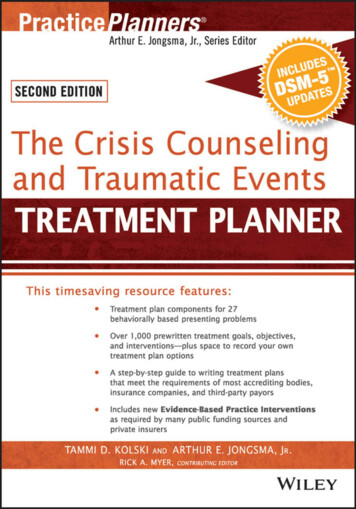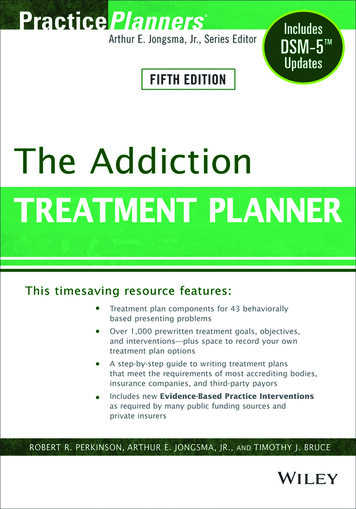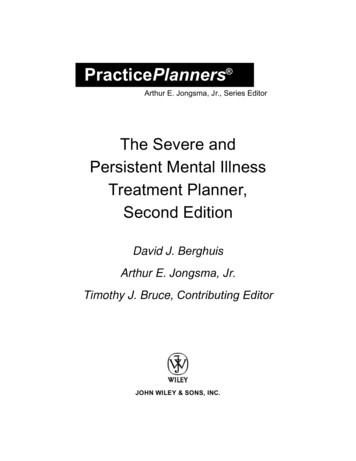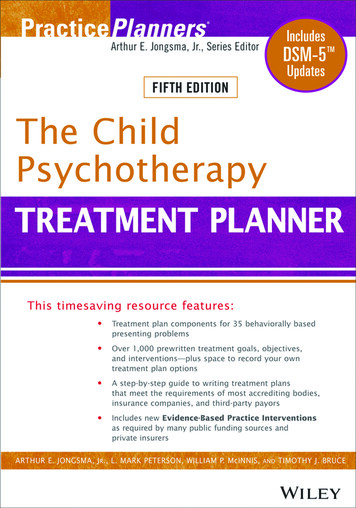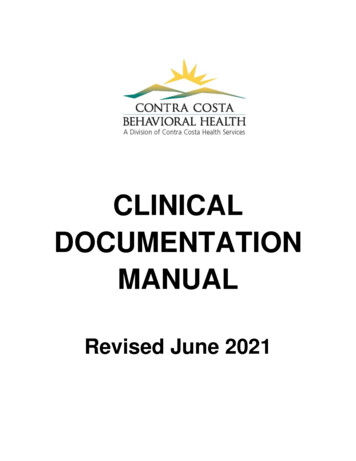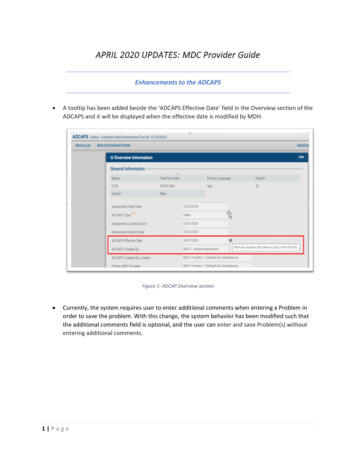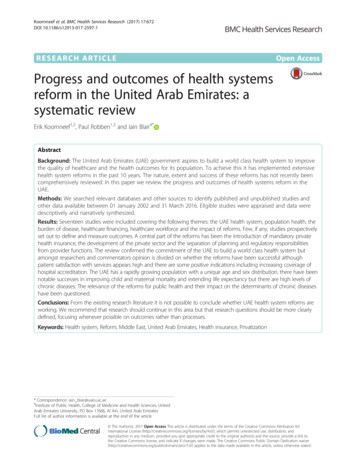
Transcription
Koornneef et al. BMC Health Services Research (2017) 17:672DOI 10.1186/s12913-017-2597-1RESEARCH ARTICLEOpen AccessProgress and outcomes of health systemsreform in the United Arab Emirates: asystematic reviewErik Koornneef1,2, Paul Robben1,3 and Iain Blair4*AbstractBackground: The United Arab Emirates (UAE) government aspires to build a world class health system to improvethe quality of healthcare and the health outcomes for its population. To achieve this it has implemented extensivehealth system reforms in the past 10 years. The nature, extent and success of these reforms has not recently beencomprehensively reviewed. In this paper we review the progress and outcomes of health systems reform in theUAE.Methods: We searched relevant databases and other sources to identify published and unpublished studies andother data available between 01 January 2002 and 31 March 2016. Eligible studies were appraised and data weredescriptively and narratively synthesized.Results: Seventeen studies were included covering the following themes: the UAE health system, population health, theburden of disease, healthcare financing, healthcare workforce and the impact of reforms. Few, if any, studies prospectivelyset out to define and measure outcomes. A central part of the reforms has been the introduction of mandatory privatehealth insurance, the development of the private sector and the separation of planning and regulatory responsibilitiesfrom provider functions. The review confirmed the commitment of the UAE to build a world class health system butamongst researchers and commentators opinion is divided on whether the reforms have been successful althoughpatient satisfaction with services appears high and there are some positive indications including increasing coverage ofhospital accreditation. The UAE has a rapidly growing population with a unique age and sex distribution, there have beennotable successes in improving child and maternal mortality and extending life expectancy but there are high levels ofchronic diseases. The relevance of the reforms for public health and their impact on the determinants of chronic diseaseshave been questioned.Conclusions: From the existing research literature it is not possible to conclude whether UAE health system reforms areworking. We recommend that research should continue in this area but that research questions should be more clearlydefined, focusing whenever possible on outcomes rather than processes.Keywords: Health system, Reform, Middle East, United Arab Emirates, Health insurance, Privatization* Correspondence: iain blair@uaeu.ac.ae4Institute of Public Health, College of Medicine and Health Sciences, UnitedArab Emirates University, PO Box 17666, Al Ain, United Arab EmiratesFull list of author information is available at the end of the article The Author(s). 2017 Open Access This article is distributed under the terms of the Creative Commons Attribution 4.0International License (http://creativecommons.org/licenses/by/4.0/), which permits unrestricted use, distribution, andreproduction in any medium, provided you give appropriate credit to the original author(s) and the source, provide a link tothe Creative Commons license, and indicate if changes were made. The Creative Commons Public Domain Dedication o/1.0/) applies to the data made available in this article, unless otherwise stated.
Koornneef et al. BMC Health Services Research (2017) 17:672BackgroundThe United Arab Emirates (UAE) is a young nation,established in 1971 as a federation of seven Emirates:Abu Dhabi, Dubai, Ajman, Umm Al Quwain, Sharjah,Fujairah and Ras Al Khaimah (Fig. 1). This newness hasallowed its leaders to deliberately plan for the development of UAE society in order to strengthen nationalunity, promote continuous economic growth and personal health and wellbeing [1].As recently as the late 1960s, in the UAE, it was reported that only half of newborn babies survived andone in three mothers died during childbirth [2]. Almost50 years later many health outcomes are on par or evenbetter than those seen in developed countries. The maternal mortality ratio (MMR) is now 8 per 100,000 livebirths (in contrast to an MMR of 14 in the USA) andthe infant mortality rate is 5.6 per 1000 live births (5.8in the USA) [3]. Healthcare in the UAE has benefitedfrom rapid economic growth and there has been a significant increase in the number of healthcare facilitiesand healthcare professionals and in levels of service use.Fig. 1 Map of United Arab Emirates showing the seven EmiratesPage 2 of 13For example, between 2011 and 2015 healthcare spending in the UAE grew by 10% to US 11 billion [4].In 2014, the Vice President and Prime Minister of theUAE, His Highness Sheikh Mohammed bin Rashid AlMaktoum, launched an ambitious set of plans with theoverall goal of making the UAE one of the best countriesin the world by 2021, the 50th anniversary of its foundation. The UAE National Agenda 2021 consists of a comprehensive set of key performance indicators (KPI) withspecific targets and clear pathways for achieving thosetargets [5]. For example, in 2016, the UAE Governmentannounced the appointment of a Minister of Happinesswhose task it is to ensure that the UAE is ranked amongthe top five countries in the world according to theWorld Happiness Report [6].The improvement of the health of its citizens and theperformance of the healthcare system form one of sevenheadings of the UAE national strategy. The KPIs includepopulation health targets, such as increasing life expectancy and reducing tobacco consumption, as well asmore structural and organizational targets, such as the
Koornneef et al. BMC Health Services Research (2017) 17:672regulatory requirement for all healthcare facilities to beexternally accredited [5]. Overall, the UAE aims to beranked amongst the top 20 countries in the world, according to the Legatum Prosperity Indicator. In 2015 theUAE was ranked 34th globally, an improvement from37th place in 2014 [7].Given its starting point, it is remarkable what has beenachieved in the UAE in the last four decades. Howeversince the early 2000s the UAE has been involved with anambitious program of health system reforms to furtherimprove health and health services and to address costand quality challenges. These reforms have focused onthe introduction of private health insurance and encouraging the growth of private health provision against aback-drop of rapid population growth and a risingprevalence of chronic disease and chronic disease riskfactors including obesity, low levels of physical activityand diabetes [8].The purpose of this paper is to describe the mainhealthcare challenges and public health issues in theUAE and review the progress and outcomes of healthsystems reform. This will be achieved by reviewing secondary data from peer-reviewed journal publications andreports of government agencies and related healthorganizations.Even though the term health system reform is regularlyused, it is rarely defined in any operational way [9]. Inthis paper we have defined health system reform as “sustained, purposeful change to improve the efficiency,equity and effectiveness of the health care sector” [10].MethodsData for this review were obtained by means of a systematic search of the published literature using definedkeywords, conducted according to Preferred ReportingItems for Systematic Reviews and Meta-Analyses(PRISMA) guidelines [11]. MEDLINE (accessed byPubMed), EMBASE and PsycINFO electronic databaseswere searched covering the period from 2002 to April2016 using a combination of the following MESH terms,free-text words, and entry terms: UAE; United ArabEmirates; Dubai; Abu Dhabi; healthcare quality, accessand evaluation; healthcare reform, health system reform,health sector reform. In addition, reference lists of published studies were searched manually for relevant articles. To minimize publication bias and improve theusefulness of our review we also conducted a thoroughanalysis of existing, publicly available “grey” literature bymeans of personal contact with senior officers at healthauthorities, government agencies and health sector organizations and a review of publications and reports fromhealth policy centers, the healthcare business sector andkey international sources. These sources included theWorld Health Organization (WHO) and its regionalPage 3 of 13office for the Eastern Mediterranean (EMRO), the Organisation for Economic Co-operation and Development(OECD), the World Bank, and local sources such as theHealth Authority Abu Dhabi (HAAD), Dubai HealthAuthority (DHA), Ministry of Health and the FederalCompetitiveness and Statistics Authority. Finally, a smallnumber of other sources were reviewed from local“think tanks” and consultancy and research firms. Theseincluded Ernst and Young, Colliers International, TheEconomist Intelligence Unit, US-UAE Business Council,Joint Commission International and Sheikh Saud binSaqr Al Qasimi Foundation for Policy Research. Eligiblestudies were those that focused on the UAE health system. Excluded studies were those that focused on healthcare in the wider region, studies that were publishedbefore 2002, articles that were not available in Englishand duplicate studies or those that formed part of alarger study. Two reviewers (EK, IB) independentlyscreened the titles and abstracts of identified studies andduplicates were removed. Studies considered eligible forfull text screening were retrieved for full review. The reviewers independently assessed the papers for eligibilityand quality, and then met to resolve any disagreementsregarding eligibility and/or quality. The key features ofthe studies were summarized using a data extractionform that recorded first author name, year, study design,setting, theme and key findings. A descriptive and narrative synthesis of the studies was carried out.ResultsWe screened 353 published articles and 17 met our inclusion criteria (Fig. 2). Of these, three related to Dubai,eight to Abu Dhabi and six were UAE-wide and all werepublished after 2010. There were four cross-sectionalstudies, six policy reviews, three data reviews, two casestudies and two literature reviews. From a careful reading of the selected papers it was possible to classify thecontent into six categories or themes. The six themesare: the UAE health system, population health, the burden of disease, healthcare financing, healthcare infrastructure and workforce and the impact of reforms(Table 1). The findings are summarized under theseheadings in the following sections. For the sake of clarity, while acknowledging the possible inferior quality, wehave included the grey literature, appropriately referenced, it in our summary along with the publishedliterature.The UAE health systemTen of the included papers discussed the UAE healthsystem. Improving the quality of healthcare as well asthe actual health outcomes for its citizens has been akey strategic goal of the UAE government since its formation in 1971. Dubai and Abu Dhabi have their own
Koornneef et al. BMC Health Services Research (2017) 17:672Page 4 of 13Fig. 2 Flow diagram of the search and selection processhealth authorities for licensing, regulation and qualityassurance. The Federal Ministry of Health (MOH) fulfilsthese functions in the other five emirates. In additionthe MOH carries out certain high level functions for allEmirates [12].In both Dubai and Abu Dhabi around 70% of outpatient visits are made to private healthcare facilitieswhile for inpatient activity in private facilities the proportion is 40% in Abu Dhabi and 60% in Dubai [13, 14].In the remaining five Emirates, the Ministry of Health isboth the regulator as well as the main provider of mosthealthcare services. According to the most recent data,in 2014, there were 36 government and 79 private hospitals in the UAE, an increase of 25% since 2009 [15].In 2006 the government of Abu Dhabi embarked on asignificant health system reform program with a clearfocus on the redesign of the healthcare financing andregulatory system [8]. The regulatory function (the responsibility of Health Authority Abu Dhabi) was separated from service provision (the responsibility of theAbu Dhabi health service company, SEHA). Also thenew system required all persons to have private healthinsurance and provides a centralized platform for automated claims processing and an improved level of accountability and transparency because of marketregulation [16]. One study reported large differences inhealthcare utilization rates between UAE nationals who,on average, used outpatient clinical services once permonth compared to expatriates where usage rates were3–4 times less [17].In 2014, Dubai also began to introduce mandatoryhealth insurance, with about one third of its residentscurrently estimated to be insured [18]. A recent reviewof the Dubai health system concluded that more effortshould be made to move from curative to preventive services [19]. The same review also found that the currentsystem of care encouraged excessive hospital utilizationand recommended a reorientation towards outpatient,home based and day surgery services.It has been reported that the rest of the UAE will follow soon with the introduction of mandatory privatehealth insurance but a final date has not been set [20].The MOH is considering introducing health insurancebut has not yet done so. In the northern Emirates, theprivate sector is less well developed than in Dubai andAbu Dhabi and the quality and cost of services varies between these two Emirates and the remainder of thecountry [17].Five of the studies examined the UAE health regulatory system with one highlighting the trend towardsregulatory fragmentation as a serious challenge to thefuture of healthcare in the UAE [18]. A further study reported the lack of regulatory control and a lack of competition between insurance companies as the two mainobstacles to achieving greater cost efficiency in thehealthcare market [21]. Researchers who evaluated theregulatory system for healthcare professionals concludedthat the UAE had made significant progress in developing and implementing best regulatory practice [12].Other research on the regulation of healthcare services
Koornneef et al. BMC Health Services Research (2017) 17:672Page 5 of 13Table 1 Summary of study characteristics included in the literature searchFirst author,YearStudy Design / Focus TopicsMethodAl Maskari, 2010 Retrospective[33]cohort studyDubai Healthcare FinancingBurden of disease(diabetes)Key FindingsAverage costs (without complications): 1605 USD, with complications 5645USD61% of all diabetes patients in the cohort reported to have suffered poorhealthduring the past monthAl Zaabi, 2014[36]Retrospectivecohort studyAbu Healthcare FinancingDhabiBurden of disease(asthma)Crude prevalence of asthma is 4.8%, much lower than expectedBlair, 2012 [21]Data reviewUAEBurden of diseaseSubstantial population growthPopulation HealthData quality needs to be improvedBlair, 2012 [27]Healthcarepolicy reviewUAEUAE Health SystemReview of UAE healthcare system 2000–2010Population HealthDramatic population growth, young populationBurden of diseaseMain causes of death: road injury, health and cerebrovascular diseasesHealthcare FinancingExpenditure has grown from 1.7 billion USD in 2000 to 9.5 billion USD in2011Healthcareinfrastructure andworkforceLargely expat clinical workforce ( 85%)Impact of reformsSatisfaction appears high but citizens still opt for treatment abroadAl Hosani, 2014Asthma treatment in the UAE costs around 200 USD per capitaHealthcarepolicy reviewUAEBurden of diseaseNational neonatal screening programBrownie, 201520]Regulatorypolicy reviewUAEHealthcare infrastructureand workforceBrief historical overview of regulation and licensing in the UAEUAE Health SystemMove towards central, consistent regulation and licensureHajat, 2012 [34]Retrospectivecohort studyAbu Burden of diseaseDhabiThis population-wide cardiovascular screening program demonstrated a highcardiovascular burden for our small sample in Abu DhabiHajat, 2012 [29]Healthcarepolicy reviewAbu Burden of diseaseDhabiLargely unhealthy lifestyle - lack of physical activity, poor diets & tobaccoconsumption[31]Population HealthWeqaya - a program aimed at improving population health (cardiovascular)Healthcare FinancingDiabetes may cost up to 1.1 billion per year in Abu DhabiUAE Health SystemWeqaya program - screened 94% of national populationHamidi, 2014[19]FocusedliteraturereviewAbu Healthcare FinancingDhabiHamidi, 2015[38]Data reviewAbu UAE Health SystemDhabiThe health care model has not fully matured yet and needs to focus oncreating a sustainable model that is affordable and provides high quality, safecareHamidi, 2015[17]Data analysisDubai UAE Health SystemChanges required to move from curative to preventive care and frominpatient to day care, outpatient and home-based careKoornneef, 2012 Healthcare[14]policy reviewLoney, 2013[25]LiteraturesearchUAE Health SystemStrategies are in place designed to slow the rise in spendingHealthcareinfrastructure andworkforceCost containment for pharmaceuticalsHealthcare FinancingStrengthen long-term careAbu Impact of reformsDhabiUAEIn Abu Dhabi there has been a significant growth in demand for healthcaresince 2007Limited information available, some evidence of improved access and patientsatisfactionUAE Health SystemThree key characteristics: centralized regulatory system, mandatory insuranceand competitionPopulation HealthUAE has significantly invested resources into population-based controlmeasuresBurden of diseaseTop four priorities: cardio, injury, cancer, respiratory diseases
Koornneef et al. BMC Health Services Research (2017) 17:672Page 6 of 13Table 1 Summary of study characteristics included in the literature search (Continued)Mosaad, 2014[28]Osenenko kmet al., 2015 [50]Healthcarepolicy reviewRetrospectivecohort studyUAEUAE Health SystemRisk factors: ageing population, population growth, health risk factorsHealthcareLack of clinical staff, hospital beds and referral networkinfrastructure and workforceUAEImpact of reformsProgress is “underway” in the UAE with a focus on quality, screening andcompetition. However, the focus is not on preventionPopulation HealthGreater understanding of the factors leading to high adherence to guidelineswould be usefulImpact of reformsCompared to international benchmarks, the patients in Dubai received similarquality outcomesSharif, 2011 [44] Case studyDubai UAE Health SystemReview of the necessary changes in the healthcare system in Dubai toaccommodate population growth and burden of diseaseVetter, 2012[15]Abu Healthcare FinancingDhabiUAE Health SystemStrong regulatory focus on cost containmentCase studyMany changes since 2006, in particular introduction of mandatory insuranceand the establishment of a regulatorin Abu Dhabi concluded that several challengesremained to be addressed, in particular with respect toquality improvement [18]. Interestingly, Abu Dhabi’shealthcare regulator itself, HAAD, concluded in 2013that “the current model of care in Abu Dhabi does notadequately support self-care or prevention and screeningprograms and diagnostic services are not integrated intocare plans. Also, patients have undirected access to services and specialty care which leads to inappropriate useand, in turn, over-supply of services” [14].Population healthFive studies addressed this topic. The UAE populationcan be characterized as young and fast growing. TheUAE population pyramid is remarkable in term itsyouthfulness and the high proportion of male expatriates[22]. Overall, the median age is 30 but amongst UAE nationals, who only account for approximately 11% of thepopulation, 79% are aged less than 35 [3, 15]. Expatriatesare typically of working age but despite this the majorityare aged 35 or less. Population growth rate has also beenremarkable. In 1950 the population was 70,000, in 1968it was 180,000 but this has now grown to 9.16 million[23, 24]. Over the last 10 years the population has morethan doubled, mainly due to large net in-migration ofexpatriates. Since the population of nationals is small,the contribution of the birth rate amongst nationals tooverall population growth is also small. For example, between 2010 and 2014, the UAE population grew by overone million. However, during this four-year period, thenational population increase by only 126,609 (birthsminus deaths). In other words, population growthamongst nationals contributed only 11.7% of total population growth. By comparison, natural growth amongstexpatriates contributed 19% of total population growthand net in-migration contributed the remaining 70%.The great majority of the expatriate population in theUAE are male, young and originally from Asian countries. For example, it is estimated that approximately 2.6million Indian nationals reside in the UAE [25]. Thetotal fertility rate (average number of children thatwould be born to a woman over her lifetime) decreasedfrom 4.4 in 1990 to 2.4 in 2010 [26]. During the sameperiod, the average life expectancy improved from72 years to 77 years [27]. The unique characteristics ofthe UAE population should play a major role in the development and implementation of health strategies andpolicies. Clearly child and maternal health services,youth services, health promotion and preventative services and occupational health services should be priorities [17]. A recurring theme from the studies that wereviewed is the need to improve health data collectionand reporting [17, 22]. For example, birth and death dataare reported but not by nationality, making it difficult todetermine what, if any, specific, targeted strategies arerequired. In summary, the demographic transition in theUAE is one characterized by declining birth and deathrates which with high net in-migration has resulted insignificant population growth [28]. There has been a second health transition in the UAE in recent decades, anepidemiological transition, characterized by a decline incommunicable diseases and a rise in non-communicableor chronic diseases, such as heart disease, diabetes andcancer [28]. This is described in the following section.The burden of diseaseEight studies discussed UAE mortality, morbidity and riskfactors. As mentioned earlier, the UAE Government hasset itself a number of challenging targets through its Vision 2021 strategy [5]. Of particular relevance are the targets to reduce the number of deaths (per 100,000population) from cardiovascular disease from 297 to 158.Other targets relate to a reduction in the number of adultswith diabetes (from 19 to 16%), a reduction of obesity
Koornneef et al. BMC Health Services Research (2017) 17:672amongst children (from 13 to 12%) and an increase in thehealthy life expectancy (from 67 to 73 years). Since its independence in 1971, the UAE has made significant progress with increased life expectancy and lower maternaland infant mortality rates [29]. However, despite theseachievements, the UAE faces a number of challenges including rising rates of non-communicable diseases such asdiabetes, cardiovascular diseases and cancer [26].The UAE has made progress with the control and prevention of communicable diseases, through a strong focuson immunization, surveillance, mandatory reporting andeffective treatment [26]. The mandatory screening of allexpatriate workers linked to the visa application and renewal process has also had an effect [30]. The nationalneonatal screening program for new born babies has beensuccessful with an increased uptake from 50% in 1998 to95% in 2010 resulting in early detection, treatment andfollow up [31]. The WHO currently estimates that worldwide around 67% of all deaths are now attributable tonon-communicable diseases, with the leading causes ofdeath reported as cardiovascular diseases, injury and cancer [32]. This is also the situation in UAE, where mortalityfrom non-communicable diseases (NCDs) among thoseaged 60 years or younger is amongst the highest in theworld. The leading causes of premature deaths in the UAEare road injury, cardiovascular disease and respiratory illnesses [17]. In the studies that we reviewed, authors identified the determinants of this health loss as unhealthylifestyles (physical inactivity, high caloric intake) and a lackof health system focus on prevention, chronic diseasemanagement, early stage interventions and inadequatetreatment options for NCDs and their complications. Assolutions, these authors proposed further research, the establishment of reliable surveillance and monitoring programs and improved training and education for healthcareprofessionals [26, 31, 33].We found five studies that described interventions toaddress the UAE burden of NCDs. One such intervention is the Abu Dhabi Weqaya program that aims toscreen adults for cardiovascular disease risk factorsfollowed by targeted follow up, treatment and secondaryprevention [34]. Weqaya has confirmed a high prevalence of cardiovascular disease risk factors amongst theadult population. Following the successful implementation of screening in a small, high-risk population usingnewly agreed UAE screening guidelines other researchers have recommended a national diabetes screening program [35]. In the review we found a number ofstudies that reviewed the direct and indirect economicburden of selected diseases, including asthma and diabetes [33, 36]. The economic burden of asthma was estimated at US 29 million in Abu Dhabi and US 24million in Dubai, an annual per capita cost of aroundUS 200, about half the cost compared to European orPage 7 of 13North American benchmarks. One of the most cited articles in the review assessed the direct medical costs ofdiabetes care, the annual cost of diabetes without complications was US 1605, similar to the costs in mostwestern countries but the treatment costs of diabetesmellitus with complications was up to 9.4 times higher[33]. The authors of these papers that reviewed the economic costs of high burden diseases typically recommended improvements in management includingnationwide early screening and rapid implementation ofbest-practice clinical guidelines as a means to improveoutcomes while controlling costs.Healthcare financingSeven studies discussed healthcare financing. Recentlypublished WHO data indicates that in the UAE over thelast 12 years, total expenditure on health as percentageof gross domestic product (GDP) has increased by over36% (from 2.2% of GDP in 2000 to 3.0% in 2012) [3]. Inabsolute terms, the UAE’s GDP rose from US 104.3 billion in 2000 to US 372.3 billion 2012, meaning thathealth spending grew from US 2.3 billion to US 11.2billion. More recent reports show a further increase toUS 13.6 billion in 2014 with an expected budget ofUS 25.7 billion by 2024 [37]. In Abu Dhabi, mandatoryhealth insurance for all nationals and expatriates hasbeen the major driver of its healthcare reform since2006 [38]. There are three different insurance schemes:two for expatriates (Basic and Enhanced) and one forUAE nationals (Thiqa). In 2011 there were 15.3 millioninsurance claims with an average cost per claim of 105giving a total insurance bill of US 1.6 billion. This hadgrown to over 22 million claims and US 2.9 billion by2014 (Additional file 1) [14]. Even though there has beena steady rise in the number of claims (Fig. 3) as well asthe overall cost, some researchers have argued that thisis appropriate because universal health insurance coverand transparent, standardized payment rules and regulation allow for better control of cost, ensure that healthneeds are met and offer patients the freedom to chooseprovider [8, 16]. However, other researchers have concluded that increasing claims and costs signal the needfor further changes to ensure long-term financial sustainability [38]. The WHO and other sources estimatethat the UAE government spent almost a quarter of itstotal healthcare expenditure in 2010 to send its citizensabroad for medical care [16, 32]. Dubai Health Authorityfor example sponsored 2717 patients in 2014 for treatment abroad, an increase of almost 2000 in 10 years(Table 2) [13]. While in 2013, Health Authority AbuDhabi sponsored over 1400 patients [14]. Also there areother referral sources for UAE nationals who wish to besent abroad for medical treatment, including the
Number claimsKoornneef et al. BMC Health Services Research (2017) ge 8 of 13Basic product (Daman)Thiqa product (Daman)Enhanced product200920102011201220132014Fig. 3 Health insurance claims by type of insurance scheme, Abu Dhabi, 2009–2014Ministry of Health, Ministry of Defense, Abu Dhabi National Oil Company (ADNOC) and other large companies [8].At the same time, the UAE is working to attractmedical tourists to its healthcare facilities, in particular its highly specialized hospitals. For example in2012, Dubai attracted over 500,000 medical tourists, afigure that is expected to grow annually by 10–15%[39]. In the UAE the level of out-of-pocket (OOP)healthcare expenses is relatively low in comparison toother countries in the region and the rest of theworld. At 20% the OOP is just above the OECD average of 17% indicating a reasonable level of financialprotection [40]. A number of studies have commentedon the low levels (ranging from 4 to 15%) of genericprescribing and the high use of branded pharmaceuticals with the inevitable implications for increasingcosts [41, 42]. In the UAE, data on health care spending is not yet available in a standardized format. Theclaims based data for Abu Dhabi shown in Table 2Table 2 Funding of International Patient Care by Dubai HealthAuthorityYearNo. UAE Patients who receivedmedical treatment outside UAEAverage costper patient(US )Total cost(US )200480840,43632,672,262200567
Even though the term health system reform is regularly used, it is rarely defined in any operational way [9]. In this paper we have defined health system reform as "sus-tained, purposeful change to improve the efficiency, equity and effectiveness of the health care sector" [10]. Methods Data for this review were obtained by means of a sys-

